Advancing
Our Technology
Semiconductor electroplating technology
New reactor and platform innovations such as these
are constantly being developed to enhance Solstice performance – optimizing gold plating, copper plating, plating rotor technology, and a lot more…
GoldPro Reactor
For quality-enhancing, throughput-increasing gold plating
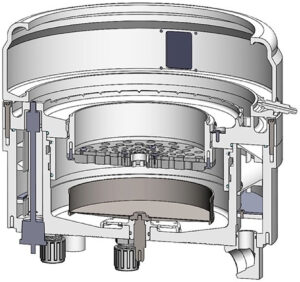
Unique design, exceptional performance
ClassOne’s GoldPro™ reactor employs a one-of-a-kind advanced design that is specifically aimed at optimizing Solstice gold plating technology. What makes it unique is that it is able to deliver exceptional plating uniformity together with high wafer throughput.
Getting both uniformity and throughput has long been a challenge in gold plating. The fundamental problem is that the gold complex ion moves much slower than copper or other metals; so, small differences in the gold plating fluid velocity at the wafer surface will cause different plating rates across the wafer – and poor uniformity.
Competitive system problems
Other gold plating systems have used various methods to try to mitigate the problems – but each has had limited success…
Immersion plating systems control fluid velocity by nozzle delivery across the wafer. And if their flow rate across the wafer is low enough, the uniformity may be acceptable. However, this necessitates slow plating to avoid hitting a limiting current density. A higher flow rate across the wafer may achieve good mixing and a higher plating rate; however, the turbulence causes different plating rates across the wafer and poor uniformity.
Spinning wafer systems use a fountain plater with higher flow rates. These systems tend to treat gold plating the same as copper or nickel; but that causes problems, because gold is fundamentally different. When these platers use high wafer rotation rates it can achieve good mixing and a thin diffusion layer for faster plating, but it also sets up consistent stream lines and directional eddies that lead to poor feature uniformity. And features that are not flat lead to bonds that do not hold, resulting in poor yield. Reducing the rpm can reduce the fluid vector bias, but it also increases the diffusion layer thickness which, in turn, prevents high plating rates.
Paddle systems introduce a mechanical paddle structure into the chamber. These systems tend to be expensive and complicated, and they often have maintenance and reliability issues. Also, paddle systems provide many additional surfaces for colloidal gold to adhere to, as well as seams from which residual gold can be hard to rinse during bath changes, resulting in a costly loss of gold.
Only GoldPro achieves both high plating rates and excellent uniformity
The proprietary GoldPro reactor employs a special wafer rotation and fluid dynamics scheme to ensure that no fluid vector ‘hotspots’ are formed on the wafer surface, and the rotation is maintained at the precise speed required to avoid center-to-edge motion.
In addition, turbulent chemistry is delivered perpendicular to the wafer and under constraint to exit the reactor. This high turbulence minimizes diffusion layer thickness so that the gold deposition rate is the same at all points across the wafer. And as the chemistry rolls away in all directions, it produces a completely random and constantly changing fluid vector against the wafer – for continuously optimized plating uniformity, even at high throughput.
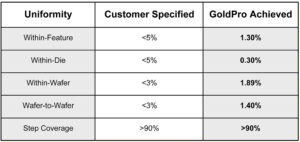
A typical example of GoldPro’s best-of-class performance, illustrated here in a customer’s through-mask gold plating application.
Precision and control
The GoldPro reactor’s unique design gives it a high degree of precision and control. Delivering plating chemistry in a high-velocity vector normal to the surface dominates the fluid dynamics and forces the highest possible exchange and randomized surface interactions for maximized fill rates.
The non-directional fluid flow profile also eliminates feature misshaping. Gold is deposited precisely where it should be deposited, and not elsewhere. For multilayer stack applications, GoldPro achieves uniform plating of individual stack features as well as the overall stack. It is able to fill features with a thin overburden and no voids. And because gold is expensive it is important that none of it is wasted; so this reactor employs an effective method of maximizing the gold bath life by combining nitrogen in the flow path.
Exclusive performance
GoldPro is the only gold plating reactor in the industry that is able to achieve a totally randomized fluid vector at the wafer surface without need for paddles or other complex mechanisms – so it can deliver maximized plating rates along with maximized uniformity. It enables the deposition of thick or thin gold layers precisely, efficiently, and rapidly – many times faster than earlier deposition methods. It achieves the highest step coverage with excellent feature fill while minimizing defect and integration issues. And very importantly, it provides significant gold savings – often, enough to pay for the Solstice equipment.

CopperMax Reactor
Significantly reducing copper plating costs
An advanced plating reactor, specifically for copper
Modern semiconductor copper plating employs highly-engineered organic additives that enable excellent plated feature characteristics. But these same additives are also very expensive and sensitive. At a cost of more than $400 per liter, consumption of additives is the single biggest operational cost for a copper plating system. Also, as the bath is used, its electrochemical activity shifts, skewing the accuracy of bath concentration monitoring. Overall, this leads to lower plating quality, lower plating rates – and increased costs.
To address these problems, ClassOne developed the proprietary CopperMax™ reactor. This advanced new reactor is able to deliver high copper plating rates and quality while greatly reducing additive usage and byproduct problems — all of which bring down the cost of copper plating significantly.
Reducing copper additive usage
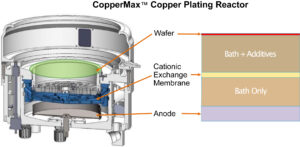 In traditional copper plating systems over 97% of the additives are actually not consumed by the plating process itself but rather, by the additives having contact with the anode.
In traditional copper plating systems over 97% of the additives are actually not consumed by the plating process itself but rather, by the additives having contact with the anode.
To address this fundamental problem, ClassOne applied a cation-exchange membrane to divide the copper plating bath into two sections. The lower section contains the anode that supplies the elemental copper – which is able to travel up through the membrane and into the upper section to ultimately plate the wafer. The upper section contains all of the additives, and it actively plates the wafer. However, the membrane prevents additives from traveling down to the anode, thus keeping them from breaking down and forming the process-damaging waste products. And the CopperMax membrane has a virtually infinite lifetime. Cationic exchange membranes have previously been used on expensive 300mm systems, but ClassOne is the first to make it available for users of 200mm and smaller wafers.
Cleaner, longer-life baths = superior plating performance
The CopperMax reactor keeps plating baths much cleaner and freer from additive byproducts, improving plating performance, extending bath life by 20x or more, and increasing uptime.
And by reducing additive consumption by over 95%, CopperMax significantly reduces the user’s cost of operation. For example, on a single Solstice plating system with six copper chambers running TSV and high-rate copper processes, the additive costs can be reduced by over $300,000 a year!
And further savings come from reduced anode costs: The CopperMax chamber design enables the use of much less expensive bulk copper pellets instead of the usual solid-machined copper anodes. This reduces anode costs by over 50%. And because pellets provide 10 times the surface area of solid anodes, they significantly boost the allowable plating rates.
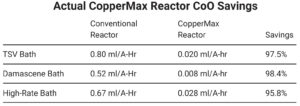
Comparison of CopperMax vs. conventional copper plating bath costs after six months of actual production usage at a user facility.
Enhanced copper plating at greatly reduced cost
The CopperMax reactor’s ability to cut plating costs was clearly demonstrated in a Solstice installation at a Fortune 100 customer. There, the user carefully tracked materials and costs for a full six-month period, comparing Solstice CopperMax against the performance of previous copper chambers; and the results were dramatic. See the CopperMax CoO savings comparison chart.
The net result is that the innovative CopperMax reactor design is able to deliver consistently higher-quality, higher-rate copper plating, while maximizing uptime, improving performance — and very dramatically reducing bottom-line operating costs.

SoftSeal Plating Rotor
A superior rotor design
A key element in advanced electroplating
In wafer electroplating systems, the rotor is vitally important because it must provide a number of critical functions:
-
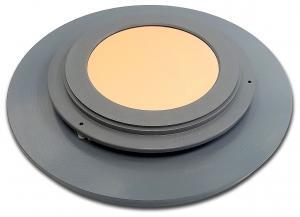
The SoftSeal rotor used on Solstice electroplating systems
- Automated gripping and handling of the wafer in the reactor
- Electrical connection to the power supply
- Uniform distribution of current around the perimeter of the wafer
- Isolation of electrical contacts from the electrolyte
- Enabling of effective chemistry reclamation (especially for gold electrolytes)
Until now, most electroplating systems have used one of two basic types of plating ring designs. The first is a simple design that provides too few contacts or does not allow for wafer rotation. The second is a complex design that is expensive and sensitive to damage from handling.
ClassOne set out to address those issues and design a better plating ring: one that was more elegant, less complex, more robust and cost-efficient, and one that would consistently optimize plating uniformity. The result was the proprietary SoftSeal™ plating rotor.
Superior plating quality, superior functionality
From the beginning, the SoftSeal rotor was designed to support wafer rotation. This is key because rotating disk electrode physics provides superior plating uniformity, and this gives SoftSeal an intrinsic advantage over stationary-wafer plating systems. In addition, this rotor provides a high density of perimeter electrical contacts, which further enhances plating uniformity.
The SoftSeal rotor also employs a high-performance FFKM elastomer to create an extremely effective seal to keep the electrolyte isolated from the edge-exclusion area. This elastomer provides a larger conformal interface and supports larger feature sizes without leakage. The captive elastomer also serves to make the unit more physically robust, to extend its usage life and reduce replacement costs.

Cross-section of SoftSeal plating rotor with elastomer sealing
Using improved methods for wafer retrieval, the SoftSeal rotor eliminates wafer bow and stress because there is no need to apply extraction force to the center of the wafer. Also, there is no need to use nitrogen. This advanced plating rotor is proven safe for substrates of all types, even thinned GaAs wafers.
After plating, a special “slingoff” feature helps to direct excess chemistry from the wafer surface back into the tank. This is particularly important with expensive chemicals such as gold which are to be reclaimed. The rotor also provides drain ports to enable rapid rinsing and drying of the wafer.
Maximum user flexibility
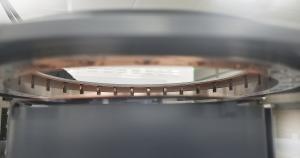
Under view of the SoftSeal plating rotor, showing its high density of electrical contacts for enhanced plating uniformity
Like all ClassOne systems and products, the SoftSeal plating rotor is designed to give users maximum flexibility. It is compatible with all Solstice electroplating applications, including gold sulfite, gold cyanide, copper, nickel, indium, alloys, etc. And its custom reach allows the rotor to fit existing integrations without requiring the user to make changes. SoftSeal readily accommodates flatted and multi-flat wafers, and it is customizable to non-standard substrate sizes. And importantly, this rotor automatically adapts to wafer thickness, so no adjustment is needed for thicker wafers.
To suit user preferences, ClassOne’s plating ring body materials are available either in CPVC or natural propylene. The elastomer is made from FFKM, an advanced, long-life material that has been industry-proven in many ECD applications. The SoftSeal plating rotor fits – and is available to retrofit – all of ClassOne’s Solstice electroplating systems.


